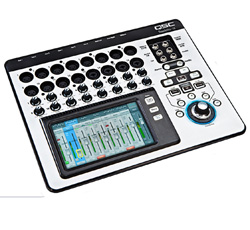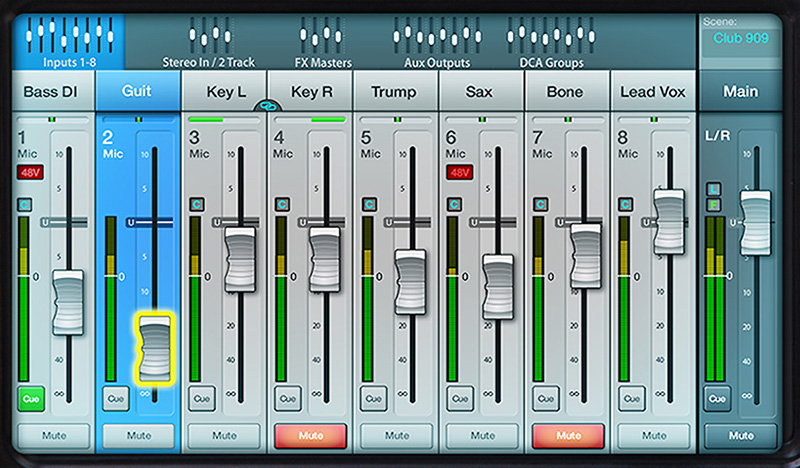
As noted earlier, these mixers are very well designed for both less- and more-experienced users. In “simple” mode, many functions are hidden and turned into basic controls.
For example, in simple mode the channel EQ is a 4-band fixed frequency unit providing boost or cut at 80 Hz, 400 Hz, 2 kHz, and 6 kHz, along with a fixed low-cut at 120 Hz and a fixed high-cut at 8 kHz. If a channel preset is recalled, the frequencies and width of the filters will change under the hood but the simple, 4-knob operation is retained.
In advanced mode, this EQ is now a 4-band fully parametric with optional shelving, with adjustable low- and high-pass.
A wireless USB dongle facilitates use of an iPad for remote control, so I grabbed mine and downloaded the app to check it out. Setup is very easy. In the mixer menu there’s a network section where you can rename the mixer and give it a new 10-digit password, then you simply connect the iPad to that network and the mixer links up on its own.
Finally, with a mic plugged, I checked out operation and sonic quality. The mixer sounds great, and I was particularly impressed with the FX units. There are 4 slots, and the user can choose between a dense reverb, lush reverb, mono delay, stereo delay, basic chorus or pitch shifter for every send.
The reverbs and delays have a ton of control parameters. Confident in it’s capabilities, I added the TouchMix-16 to a system staged for a multi-day festival that would be loading in the next morning.
In The Field
At the festival we provided main stage sound reinforcement, distributed audio for the grounds, audio for an outdoor movie, and distributed audio. The first day we used the TouchMix-16 for the movie system. The supplied Blue-Ray player only had RCA outputs, so we used a pair of adapters to plug them into the combo inputs on channels 15 and 16. The main outputs were linked to the loudspeakers, and I booted up my iPad to use the mixer to fine-tune the system in the listening area. Perfect.
The next day we moved the mixer to the tent and used it to route theme music from a laptop to powered loudspeakers. It was easy to optimize EQ via the “touch and turn” operation provided by the touch screen and rotary knob. Fast, intuitive and accurate.
From there we took the TouchMix-16 to a corporate event with presenters, video playback and live music bolstered with backing tracks. We were given very little setup time, so I decided to place the mixer next to the stage and mostly mix on the iPad.
The music act had two different laptops with backing tracks, a keyboard with stereo out, keyboard module with stereo output, acoustic electric guitar and two vocal mics. They also required two monitor mixes for floor wedges and wanted reverb in their monitors. It’s an application right in the wheelhouse of this mixer.
When the musicians asked me for reverb in their wedges, I hesitated for a second and then remembered seeing FX sends on the aux overview page. Sure enough, one button press was all it took to take me to the right page where I could dial in any of the 4 effects to any aux bus. The artists were happy, the audience had a great time, my client was pleased – and so was I, impressed with the capabilities of this mixer, in addition to really enjoying mixing on it.
Both TouchMix models are a perfect fit for a wide range of needs for rental companies, as well as smaller applications such as houses of worship and performing musicians. Based upon my evaluation, these mixers are highly recommended.
U.S. MSRP: TouchMix-16 – $1,799.99; TouchMix-8 – $1,199.99
To comment on this review and/or ask Craig questions, go to the PSW Road Test Forum. Find out more about the TouchMix Series here.
Senior contributing editor Craig Leerman is the owner of Tech Works, a production company based in Las Vegas.


